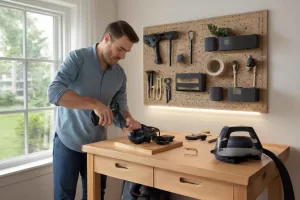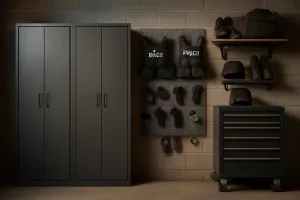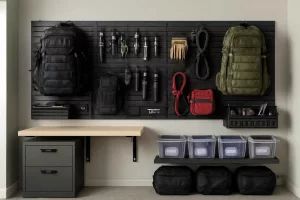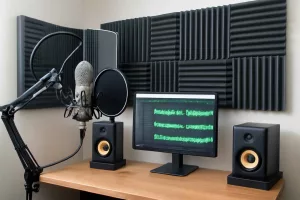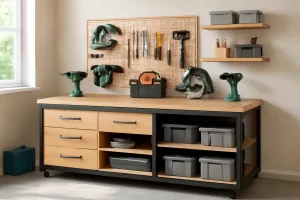Setting up a home recording studio in a small room comes with its share of challenges: limited desk space, awkward room dimensions, and the constant battle against clutter. However, with the right gear for home recording studio that prioritizes compactness and efficiency, you can craft a professional-sounding environment without sacrificing square footage. Whether you�re a singer-songwriter working from a closet-sized booth or a podcaster needing a tidy corner, this guide covers the essential space-saving tools that will transform your compact area into a versatile production hub. To kick things off, consider a key piece of equipment like a compact audio interface that fits neatly beside your laptop, or invest in studio monitors designed for small desks. These versatile options are the foundation for a streamlined setup that doesn�t compromise on sound quality.
Why Prioritize Space-Saving Gear in Your Home Recording Studio
In a crowded world where every square foot counts, investing in gear for home recording studio that fits into compact layouts is an intelligent strategy. Small studios often struggle with acoustics, noise control, and cable clutter. A thoughtfully selected compact setup addresses these pain points by limiting physical footprint, reducing unnecessary cables, and allowing flexible positioning. For instance, ultra-slim audio interfaces and foldable microphone stands can be stowed away when not in use, reclaiming valuable desktop or floor space. This agility is invaluable for multi-purpose rooms where you may need to switch between recording, editing, and general home office tasks.
Moreover, space-saving gear often boasts enhanced portability. Lightweight controllers, collapsible mic arms, and compact monitor stands enable you to reconfigure your layout to match the demands of each session. If you�re collaborating with other creators or traveling between workspaces, these modular components streamline setup and teardown. The streamlined design of modern recording tools also typically emphasizes intuitive controls and streamlined features—so you trade bulk for user-friendly interfaces without losing studio-grade functionality.
Finally, smaller equipment helps to minimize acoustic issues. Oversized monitors or mics placed too close to room boundaries can exacerbate unwanted reflections. Compact units allow for precise placement in optimal listening zones, which is crucial in tight spaces. By embracing gear for home recording studio that�s engineered for limited environments, you position yourself for better mixes, greater flexibility, and a workspace that inspires creativity rather than overwhelming it.
Top Compact Audio Interfaces for Tight Spaces
Choosing the right audio interface is paramount for any home studio, but space constraints demand a model that�s both small and mighty. Look for bus-powered interfaces that draw power over USB, eliminating the need for bulky adapters. A popular midsize choice is the Focusrite Scarlett Solo, which offers a single microphone input with excellent preamps in a sleek chassis that fits neatly beside a laptop. For those needing dual-channel recording without added dimensions, the PreSonus AudioBox USB 96 delivers two XLR-1/4″ combo inputs and MIDI I/O in a compact metal enclosure that tucks under most monitors.
Another standout is the Audient iD4, celebrated for its professional-grade preamp and low-latency performance, all within an enclosure small enough to hold in one hand. Its streamlined front-panel layout keeps knobs and buttons to a minimum, freeing desk space for monitors or a laptop. Many of these compact interfaces also include software bundles, giving you immediate access to DAW tools and virtual instruments so your recording rig is production-ready from day one.
When selecting an interface, consider rack-mountable options if you�re building a small rack workstation. A 1U rack adapter can house a mini interface alongside external drives or sync modules, neatly consolidating gear. Be sure to verify compatibility with your computer�s operating system and DAW, and look for USB-C or Thunderbolt connectivity if you prefer the fastest data transfer paths. Investing in a space-saving audio interface ensures you maintain high-quality audio capture without monopolizing your precious desktop real estate.
Space-Efficient Studio Monitors to Fit Any Setup
Your choice of studio monitors significantly influences your mixing gains, but classic large woofers and big cabinets can overwhelm a small space. Enter nearfield monitors with 4- or 5-inch drivers designed to focus sound directly at the listening position. The KRK Rokit 5 G4, for example, offers a balanced low end and visual feedback through built-in graphic equalizers—all within a modest frame. Likewise, the JBL 305P MkII delivers detailed imaging in an ultra-compact housing, allowing you to position them on a desk or small stands without overwhelming your room.
To maximize the utility of space-saving monitors, consider using isolation pads or angled monitor stands. Isolation pads decouple the monitors from the desk surface, reducing unwanted vibrations and reflections while allowing you to stack items underneath. Angled stands enable precise tilt adjustments so you can optimize the sweet spot without moving your entire desk. If you�re tight on horizontal space, look for wall-mounted monitor brackets that securely hold speakers off furniture and leave your desk surface clear.
For those working in a corner or near walls, compact monitors often include boundary EQ controls to compensate for bass buildup. Take advantage of these room-correction features so your mixes translate well beyond your small studio. While subwoofers can be overkill in compact environments, some modern monitors incorporate built-in low-frequency management, giving you a broader frequency response without doubling the gear footprint. By selecting space-efficient studio monitors, you balance accurate sound reproduction with a footprint that respects your spatial limitations.
Portable Microphones and Headphones: Versatile and Compact Options
Microphones and headphones are personal essentials that can either clutter a desk or transform your workflow with clever design. USB-powered microphones like the Rode NT-USB Mini or the Audio-Technica AT2020 USB deliver plug-and-play convenience in smaller footprints than traditional large-diaphragm condensers. Their integrated headphone outputs and compact form factors mean you can record vocals or podcasts on a tiny fold-out desk without requiring additional preamps or phantom power supplies.
For XLR users, miniature condenser mics such as the Shure MV5 or the sE Electronics sE2200a II pack studio-quality caps into diminutive bodies. Pair them with a small interface to set up a clean, minimal rig that�s ready to go at a moment�s notice. Boom arms with clamp mounts also free up desk space compared to traditional mic stands, and they can fold neatly away when not in use.
Headphones are another key area for space-saving solutions. Closed-back models with foldable earcups—like the Sennheiser HD 280 Pro or Audio-Technica ATH-M50x—provide accurate monitoring while easily stowing in a drawer or hanging from a simple hook on the wall. Wireless monitoring is an option, too, with low-latency headphone systems that eliminate cable tangles. Regardless of your choice, look for padded headbands and replaceable ear cushions to ensure long-term comfort without adding bulk.
By selecting microphones and headphones designed for portability and space efficiency, you preserve valuable desktop and rack space for other critical components. This centralizes your workflow and minimizes setup time, giving you more focus on creativity and less on gear management.
Slimline Controllers, Mixers, and MIDI Keyboards
When your desk is already populated by interfaces, monitors, and a laptop, finding room for additional controllers can feel impossible. Fortunately, manufacturers offer slimline control surfaces, mixers, and MIDI keyboards made for tight environments. The Akai MPK Mini MK3, for example, is a 25-key MIDI keyboard with assignable knobs and pads, all in a chassis smaller than many desktop calculators. It�s light enough to place on top of your laptop when not in use and never demands a separate power brick.
For tactile mixing, compact mixers like the Mackie Mix5 or Behringer Xenyx 502 offer essential gain controls, EQ bands, and headphone monitoring in a footprint smaller than a legal pad. These micro mixers facilitate live tracking and balanced headphone mixes without sprawling channel strips. Some models also include built-in compressors and EQ presets, enhancing your vocal and instrument recordings without adding rack-mounted processors.
Touch-sensitive control surfaces such as the PreSonus FaderPort 8 provide motorized faders and transport controls in a low-profile frame. This allows precise level adjustments without using a mouse or cranking knobs on a bulky console. Many DAWs recognize these devices out of the box, providing hands-on mixing without invading your available workspace. By choosing slimline controllers, mixers, and keyboards engineered for minimalism, you maintain a tactile workflow that elevates your productivity while conserving every inch of desk space.
Acoustic Treatment and Soundproofing Solutions for Small Rooms
Small spaces often suffer from reflections, flutter echoes, and bass buildup, which can mislead your mixing decisions. Strategic acoustic treatment is non-negotiable, even in the most compact settings. Installing thin, wall-mounted acoustic foam panels can dramatically reduce high-frequency reflections without protruding more than an inch or two. For low-end control, corner-hugging bass traps absorb troublesome standing waves without encroaching on floor space. To learn how to soundproof walls and floors effectively in a budget-friendly way, check out our DIY soundproofing home workshop guide.
In addition to foam panels and bass traps, consider acoustic caulk for sealing gaps around doors and windows to prevent sound leakage and external noise intrusion. Our acoustic caulk guide offers recommendations on products that remain flexible over time and won�t stain or crack. Reflective panels made of thin wood or perforated MDF can also serve as design-forward treatment, blending aesthetics with function. When hanging panels, use adhesive strips or thin cleats that keep the panel flush to walls, preserving a neat appearance and freeing up floor room.
Ceiling clouds are another compact solution: suspended acoustic elements that hang from the ceiling absorb reflections without touching vertical surfaces. These cloud panels can be shaped to complement your studio�s décor, providing a professional finish in a small footprint. By deploying a mix of low-profile absorption and diffusion elements, you�ll dramatically improve clarity and balance, ensuring your compact gear setup benefits from optimized acoustics.
Clever Studio Organization and Cable Management Strategies
Gear is only as effective as its accessibility. In small studios, messes and tangled cables not only look unprofessional—they impede creativity. Start by prioritizing tidy routing using cable ties and under-desk trays. For power distribution and USB hubs, integrate a dedicated mount beneath your desk surface. You can follow our under-desk power strips & cable management guide to discover versatile mounting techniques that keep cables off the floor and outlets within reach.
Wall-mounted organizers, such as pegboards or rail systems, help you hang headphones, microphones, and small controllers when not in use. Magnetic strips alongside the desk can hold tool kits, adapter plates, and memory cards, turning idle wall space into a functional storage zone. If you�re using a desktop PC or external hard drives, a small rack shelf can be attached to a compact desk frame, elevating hardware off the desk and improving ventilation.
Drawer organizers and stackable bins also play a vital role in keeping your desk uncluttered. Label each section clearly—cables, adapters, and accessories—so you can grab what you need mid-session without disrupting your creative flow. Additionally, consider rolling carts or slimline utility trolleys that can slide into a closet or beneath a table when not required. These mobile storage solutions allow you to expand your workspace temporarily and then conceal excess gear once you finish your project.
Budget-Friendly Space-Saving Gear Recommendations
Creating a compact, professional-grade home studio doesn�t have to break the bank. Here are a few budget-friendly picks that deliver quality while minimizing space: the Behringer UMC22 is a sub-$60 audio interface with clean preamps and bus power. The Mackie CR3-G desktop monitors cost under $100 a pair and come in a slim format perfect for tight desks. For microphones, the FIFINE K669 USB condenser mic offers strong sensitivity and onboard gain control for less than $50.
When shopping for controllers, the Korg nanoKEY Studio provides a four-in-one wireless MIDI solution—keyboard, knobs, XY pad, and drum pads—in a device barely larger than a smartphone. Acoustic panels can be DIY produced using rock wool batts and fabric for under $100, offering the same performance as branded kits. For more advanced rack-mounted equipment tips, explore our essential rack gear guide for budget-conscious recommendations that won�t overload your space or wallet.
Remember, smart placement and multi-functionality often trump outright horsepower. Opt for gear that can serve multiple roles—such as combo preamp/interface units or multi-pattern microphones—so you reduce the number of single-purpose items you need to store. By combining these budget-friendly, space-saving tools, you�ll build a home studio that feels spacious, sounds accurate, and keeps your finances in check.
Conclusion
Setting up a home recording studio in a limited area is entirely achievable with the right combination of compact, efficient gear and intelligent organization strategies. From space-saving audio interfaces and slimline monitors to foldable controllers and clever cable management, each piece of equipment plays a role in maximizing your creative environment. Couple these with targeted acoustic treatment and smart storage solutions to maintain both performance and aesthetics. Embrace the challenge of minimal space, and you�ll discover a streamlined, professional-grade setup that supports your artistic vision without occupying more room than necessary.

